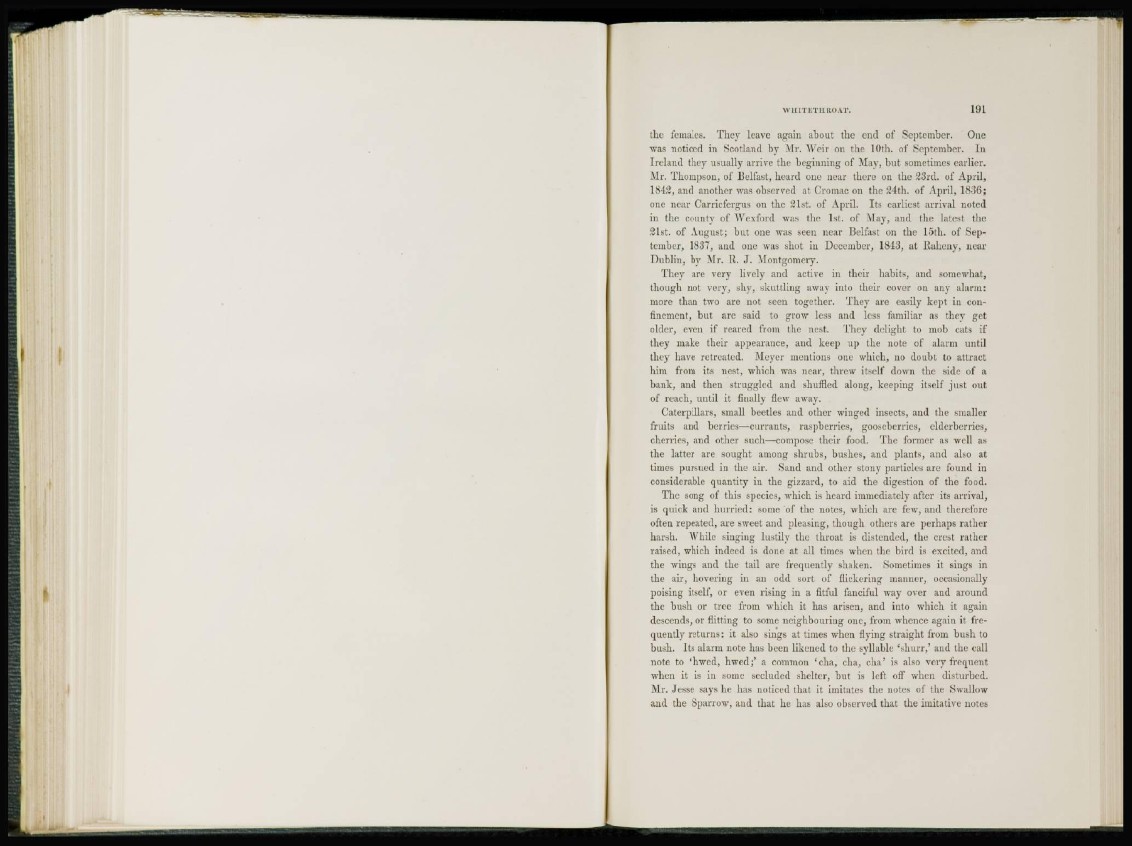
WHITE TH BOAT. 191
the females. They leave again ahout the end of September. One
was noticed in Scotland by Mr. Weir on the 10th. of September. In
Ireland they usually arrive the beginning of May, but sometimes earlier.
Mr. Thompson, of Belfast, heard one near there on the 23rd. of April,
1842, and another was observed at Cromac on the 24th. of April, 1836;
one near Carricfergus on the 21st. of April. Its earliest arrival noted
in the county of Wexford was the 1st. of May, and the latest the
21st. of August; but one was seen near Belfast on the 15th. of September,
1837, and one was shot in December, 1843, at Haheny, near
Dublin, by Mr. R. J. Montgomery.
They are very lively and active in their habits, and somewhat,
though not very, shy, shuttling away into their cover on any alarm:
more than two are not seen together. They are easily kept in confinement,
but are said to grow less and less familiar as they get
older, even if reared from the nest. They delight to mob cats if
they make their appearance, and keep up the note of alarm until
they have retreated. Meyer mentions one which, no doubt to attract
him from its nest, which was near, threw itself down the side of a
bank, and then struggled and shuffled along, keeping itself just out
of reach, until it finally flew away.
Caterpillars, small beetles and other winged insects, and the smaller
fruits and berries—currants, raspberries, gooseberries, elderberries,
cherries, and other such—compose their food. The former as well as
the latter are sought among shrubs, bushes, and plants, and also at
times pursued in the air. Sand and other stony particles are found in
considerable quantity in the gizzard, to aid the digestion of the food.
The song of this species, which is heard immediately after its arrival,
is quick and hurried: some of the notes, which are few, and therefore
often repeated, are sweet and pleasing, though others are perhaps rather
harsh. While singing lustily the throat is distended, the crest rather
raised, which indeed is done at all times when the bird is excited, and
the wings and the tail are frequently shaken. Sometimes it sings in
the air, hovering in an odd sort of flickering manner, occasionally
poising itself, or even rising in a fitful fanciful way over and around
the bush or tree from which it has arisen, and into which it again
descends, or flitting to some neighbouring one, from whence again it frequently
returns: it also sings at times when flying straight from bush to
bush. Its alarm note has been likened to the syllable 'shurr,' and the call
note to 'hwed, hwed;' a common (cha, cha, cha' is also very frequent
when it is in some secluded shelter, but is left off when disturbed.
Mr. Jesse says he has noticed that it imitates the notes of the Swallow
and the Sparrow, and that he has also observed that the imitative notes